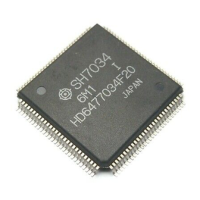456
4. Page programming mode cannot be used. Always set the equipment to byte programming
mode.
5. The capacity of the on-chip ROM is 64 kbytes, so the data of PROM programmer addresses
H'10000–H'1FFFF should be H'FF. Always set the range for PROM addresses to H'0000–
H'FFFF.
6. When write errors occur on consecutive addresses, stop writing. Check to see if there are any
abnormalities in the EPROM programmer and socket adapter.
17.3.4 Reliability after Writing
After programming, it is recommended that the device be left to stand at a high temperature to
increase the reliability of data retention. Letting it stand at a high temperature is a type of
screening method that can eliminate of initial data retention defects of the on-chip PROM's
memory cells within a short period of time. Figure 17.6 shows the flow from programming of the
on-chip PROM, including screening, to mounting on the device board.
Writing and verification
of program
Mount on board
Flowchart
from figure 17.4
Let stand in nonconductive,
high temperature environment
(125–150°C, 24–48 hours)
Data read and verification
(V
CC
= 5.0 V)
Figure 17.6 Screening Flow
If abnormalities are found when the program is written and verified or the program is read and
checked after writing/verification or letting the chip stand at high temperature, contact Hitachi's
engineering department.

